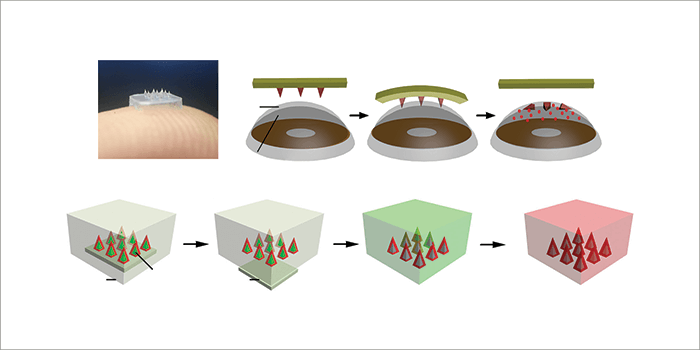
Ocular drug delivery has its challenges; namely, that it requires high systemic doses, frequent topical doses (poor bioavailability and increased likelihood of side effects) or somewhat invasive intravitreal injections (not exactly welcomed by patients, so a non-compliance burden). Now, researchers at Nanyang Technological University, Singapore, believe they have found the answer… But it does still look like a miniature medieval torture device (1).
What is it?
A flexible eye patch with an array of detachable methacrylated hyaluronic (meHA)-based microneedles that are capable of releasing two different drugs at two different rates.
How does it work?
The microneedles are fabricated with a double layer of meHA and standard HA – which can act as micro-reservoirs for one or two therapeutic compounds, allowing biphasic controlled release. The meHA shell retains its structural integrity as a sharp point, dissolving slowly, while the HA-drug contained within the shell allows more rapid release after the microneedles have penetrated the ocular barrier. In theory, two drugs could work in tandem to offer a potentially more effective treatment for a variety of ocular diseases.
How is it applied?
Much like a contact lens. The patch is placed on the eye, the microneedles detach from the substrate, which can then be peeled away – all within 60 seconds.
And the benefits?
According to Professor Peng Chen, who led the study, “high drug bioavailability compared with conventional topic administration, much better patient compliance and safety compared with conventional intraocular injection, high efficacy due to controlled drug release kinetics and, most importantly, the potential to use a combination of drugs.”
What’s next?
In the paper, Chen and his team assessed quick release of an anti-inflammatory compound (diclofenac) and sustained release of anti-VEGF to counter corneal neovascularization in an alkali burn-injury murine model – but the list of potential applications is long. “There are no apparent limitations to the type of drugs the patch can deliver. Our ultimate goal is to translate the technology to treat other ocular diseases,” says Chen.
References
- A Than et al., “Self-implantable double-layered micro-drug-reservoirs for efficient and controlled ocular drug delivery”, Nat Commun, 9, 1, 4433 (2018). PMID: 30401883.
